E-Governance Paradigm with Cloud Envirnoment
Dr Neha Paliwal
Asst Prof(Computer Department)
Mahaveer College of Commerce
Abstract
Most of the companies including government organizations are running their applications in the cloud due to the rapid progressive in ICT. In current years cloud computing is one of the most considerabily achieved development in the IT industry which gives a proposals to use the application in the form of services which is more scalable, trustworthy, high performance and relatively low cost as compared to other distributed computing infrastructure. E-Governance is one of the applications of ITC to enable and exchange the information between the G2G, G2C, G2B, G2E modality of society. So it can be seen simply as moving citizen services online, but in its broadest sense it implies to the technology-enabled transformation of government. It reduce costs, whilst promoting economic development, increasing transparency in government, improving service deliverance and public administration, and facilitating the progressive of an information society. So for e-gov cloud implementation, resources for e- governance modality can be mapped to the services and deployment models. Though the e-Gov cloud deployment is a greatest confront of ICT, but the major confront is the security and protection to both government and the citizens. The major objective of this paper is to provide a clear idea about the e-Gov using cloud computing models and outlines the problems and requirements for accepting the e-Gov paradigm in India.
Keywords: E-Governance ,Cloud computing ,Cloud computing models, e-gov using cloud infrastructure.
Introduction
E-Governance
E-Governance implies to the use of information and communications technologies (ICT) to advance the efficiency, effectiveness, transparency and accountability of government [1]. E-Government can be seen simply as moving citizen services online, but in its broadest sense it implies to the technology-enabled transformation of government best hope to reduce costs, whilst promoting economic development, increasing transparency in government, improving service deliverance and public administration, and facilitating the progressive of an information society.[1][2][3] The major objectives are:
- Reducing Costs.
Putting services on-line substantially decreases the processing costs of many activities compared with the manual way of handling operations. Efficiency is also attained by streamlining internal processes and by enabling faster and more informed decision making.
- Promoting Economic development
Technology enables governments to create positive business climates by simplifying relationships with businesses and reducing the administrative steps needed to comply with regulatory obligations. There is a direct impact on the economy, as in the case of e-procurement, which creates wider competition and more participants in the public sector marketplace.
- Enhancing Transparency and Accountability
E-Government helps to increase the transparency of decision-making processes by making information accessible – publishing government debates and minutes, budgets and expenditure statements, outcomes and rationales for key decisions, and in some cases, allowing the on-line tracking of applications on the web by the public and press.
- Improving Service Deliverance:
Government service deliverance, in the traditional process, is time consuming, lacks transparency, and leads to citizen and business dissatisfaction. By putting government services online, eGovernment reduces bureaucracy and enhances the quality of services in terms of time, content and accessibility.
- ImprovingPublicAdministration-
e-government administrative components, such as a computerized treasury, integrated financial management information systems, and human resource management systems, lead to greater efficiency in public administration. Features include the integration of expenditure and receipt data, control of expenditure, human resources management, intelligent audit through data analysis and the publishing of financial data.
- Facilitating an E-Society
One of the major benefits of an e-Governance initiative consists of the promotion of ICT use in other sectors. The technological and management capacities required for e-Government administration encourage, in turn, the development of new training courses and modules in schools and universities trying to supply the required skills and capabilities to the market.
E-Governance Facilities
- Government to Citizen:
It deals with the relationship between government and citizens. G2C allows citizens to access government information and services instantly, conveniently, from everywhere, by use of multiple channels. [1]
- Government to Business:
It consists of e-interactions between government and the private sector. The opportunity to conduct online transactions with government reduces red tape and simplifies regulatory processes, therefore helping businesses to become more competitive. [1]
- Government to Government:
Governments depend on other levels of government within the state to effectively deliver services and allocate responsibilities. In promoting citizen-centric service, a single access point to government is the ultimate goal, for which cooperation among different governmental departments and agencies is necessary. G2G facilitates the sharing of databases, resources and capabilities, enhancing the efficiency and effectiveness of processes. [1][2]
National E-Governance Plan (NEGP)
National e-Governance Plan (NeGP) has been approved by the Government of India for implementation during the years 2003-2007 to lay foundation and provide impetus to e-Governance throughout the Country. The Plan advocates definition of institutional mechanisms and core policies for managing e-governance initiatives across the Country in a cohesive manner and entails that services, having high volume of citizen interactions, with major impact on National and Regional economies or where service-owners themselves show readiness to optimize, be targeted as Mission Mode Projects (MMPs) at various levels.[1][5]
Further, by providing appropriate weightage to quality and speed of optimization and by utilizing full potential of private sector involvement, NeGP aims at creating a citizen-centric and business-centric environment for governance. [5]However, it was observed that most States were inadequately equipped in terms of personnel and skill-sets needed to handle the host of issues involved in effective implementation of NeGP in their respective areas. State Governments needed to provide for overall direction, standardization and consistency across initiatives and at the same time, were to have resources and flexibility to drive the Plan in the best-possible manner.
The E-Governance Strategy In India
- Localize implementation and decision-making and deploy the core infrastructure to deliver services to the Third Tier of Governance [5]
- Manage all ICT initiatives as ³capital investments´ which can be evaluated in terms of pre-defined goals and measurable targets
- Make various stakeholders capable of conceptualizing, developing and managing e-Governance tools themselves
- Aim at service-oriented approach of Governance and create an integrated, modular and scalable framework to become more adaptive
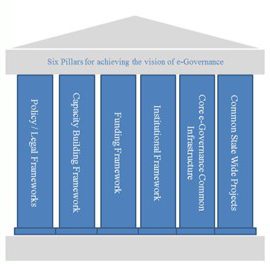
figure-1 outlines the Six pillars for achieving e-Governance
- Utilize policies, structures and frameworks to bring about transparency in various government functions. [5][6]
Fig-1. Six pillars for achieving e-Governance framework[1]
Major Implementation Confronts In India
Poor people and poor infrastructure are major confronts in countries like India. It poses a major confront in reaping the full benefits of service provision under e- governance. The various barriers can be enumerated as follows: [5][6]
- Poverty:
Accessing Internet is a costly affair for the poor who struggle for their livelihood in developing countries like India. Required infrastructure in the form of installing the necessary telephone lines needed for internet or email access is equally unaffordable in most poor countries.
- Technical illiteracy:
There is general lack of technical literacy as well as literacy in countries like India.
- Language Dominance:
The dominance of English on the internet constrains the access of non-English- speaking population. In the case of India, 95 percent of the population does not speak English. Due to such overwhelming dominance of English over these communication channels, computers and the internet are quite useless in Indian villages.
- Unawareness:There is general lack of awareness regarding benefits of E-Governance as well as the process involved in implementing successful G-C, G-G and G-B projects.
- Inequality:
Inequality in gaining access to public sector services between various sections of citizens, especially between urban and rural communities, between the educated and illiterate, and between the rich and poor.
- Infrastructure:
Lack of necessary infrastructure like electricity, internet, technology and ways of communications will affect the speed which delays the implementation.
- Impediments for the Re-Engineering process:
Implementation of E-Governance projects requires lots of restructuring in administrative processes, redefining of administrative procedures and formats which finds the resistance in almost all the departments at all the levels. [5]
Cloud Computing
Cloud computing is a next generation computing proposals that helps the users to share the resources through communication mediums. According to National Institute of Standards and Technology (NIST) one of the most accepted definition of cloud computing is ³Cloud computing is a model for enabling ubiquitous, convenient, on-demand network access to a shared pool of configurable computing resources (e.g., networks, servers, storage, applications, and services) that can be rapidly provisioned and released with minimal management effort or service provider interaction´. European Community for Software and Software Services (ECSS) defines ³cloud computing as the deliverance of computational resources from a location other than your current one´.[7][8][9] So in simple words cloud computing can be defined as a distributed computing environment that enables the users to access and exchange their resources (applications and data) remotely and provides services to use the remote hardware and software within a network without the knowledge of technological infrastructure . The figure-2 shown below gives a clear idea regarding the infrastructure requirements for cloud deployment.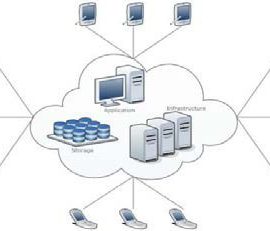
Fig-2 The Cloud infrastructure
Advantages of Cloud Computing
- Flexibility/Elasticity:
Users can access computing resources as and when needed, without any human interaction. Capabilities can be
rapidly and elastically provided in some cases automatically.[7][20][22]
- Scalability of Infrastructure
New nodes can be added or removed from the network as can physical servers, with limited modifications to infrastructure set up and software. Cloud architecture can horizontally or vertically according to the users requirements.[7][22]
- Broad Network
Capabilities are available over the network and accessed through standard mechanisms that promotes by using heterogeneous proposalss (like mobile phones, laptops, and PDAs).
- Location
Cloud interfaces are location independent and they can be accessed by well established interfaces such as Web services and Web browsers, so that no knowledge about exact location of the user is required. It gives a high level of abstraction to the users data.
- Unlimited Storage.
Storing information in the cloud gives almost unlimited storage capacity. Hence no more need to worry about running out of storage space or increasing current storage space availability.
- Easy Access to Information.
Once registered in the cloud environment any one can access the information from any location provided, there is an Internet connection.
- Economies of Scale And Cost Effectiveness.
Cloud implementations regardless of the deployment models tend to be as large as possible in order to take advantage of economies of scale. Large cloud deployments can often be located close to cheap deployment to lower cost. It does not require upfront investment and much capital expenditure. Users may pay and use or pay for services and capacity as they need them. [22]
- Backup and
Since all the user’s data is stored in the cloud , backiing it up and restoring the same is relatively much easier than storing the same on a physical device.Most cloud service providers are usually competent enough to handle recovery of information. Hence this makes the entire process of backup and recovery much simpler than other traditional methods of data storage.[7]
- Reliability
It advances the use of multiple sites which makes cloud computing suitable for business continuity and disaster recovery.
- Sustainability
It advances resource utilization and makes the cloud environment more efficient.
Cloud Computing service Models
Infrastructure as a Service(IaaS)
Infrastructure as a Service (IaaS) is one of the three fundamental service models of cloud computing . A services of cloud computing models is shown in the figure -3. In this model the users are allocated with computing resources in order to run their applications. The computing services are provided in a virtualized environment i.e in cloud by using a communication network. The best known example of IaaS is Amazon Cloud Formation, Amazon EC2. It can be implemented by utilizing the concepts like Enterprise infrastructure, Cloud hosting, and Virtual Data Centers (VDC). Network as a service (NaaS) is a category of cloud infrastructure services where the user can use the network connectivity as a services. NaaS involves the optimization of resource allocations and resource computing in the network. VPN, and bandwidth on demand are the common example of NaaS.[14,15,16,22]
Advantages of IaaS.
- Resources are available on demand as and when the user requires it. That means the user will not have to worry about the Infrastructure required to run the application. so this
- In IaaS the Infrastructure the virtualized environment is set up and majortained by the cloud provider. So no investment in hardware for the users. As it saves the implementation cost and time of
- The service can be accessed on demand and the client only pays for the resource or application used not for the Infrastructure
- The service can be accessed from any location 24X7 provided there is an internet connection. So IaaS is location
- Physical security of users data is the responsibility of the cloud provider. So the time required to give security to data is saved.
- The chance of system failure is Any case of failure will be smoothly handled by the service provider. So it is fault tolerant.
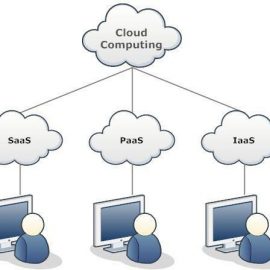
Fig-3 The layers of cloud service models
Proposals as a Service(PaaS).
Proposals as a Service is a category of cloud computing service model that provides the developers a proposals to build and use applications and services by using a communication network. PaaS services are available in the cloud and accessed by users by using web browsers. In the PaaS model, cloud providers provides a proposals which includes operating system, programming language execution environment, database, and web server. The users can use these facilities to develop their applications. The well known PaaS providers are AWS Elastic Beanstalk, Cloud Foundry, Heroku, Force.com, OrangeScape. The services are constantly updated by the service providers, with existing features upgraded and additional features added. In PaaS services the user has to pay for a subscription basis and charged just for what they use. PaaS includes Operating system, Server-side scripting environment, Database management system, Server Software, Network access ,Tools for design and development and web hosting.[22]
Advantages of PaaS:
- The user doesn’t have to invest for physical infrastructure aws it will be provided by IaaS on demand.So this gives fully mobility to focus on the development of applications.
- With PaaS services application development is simple. So anyone can develop an application with less technical knowledge by using web
- User can have control over the applications that are installed within their proposalss and can create a platform that suits their specific requirements. They can pick and choose the features they feel as necessary.
- In PaaS applications can be changed or modified if
- The services are not isolated, application specific or location dependent. So users in various locations can work together provided they are connected through a communication
- Security of users data and the application is the responsibility of the cloud provider. Data security, backupand recovery are the major security issues.
Software as a Service(SaaS)
The third model is Software as a Service which provides a proposals in which the users access the software from the cloud. The users of SaaS will not have to worried about managing the cloud infrastructure and proposals on which the application is running. The software installation and operation is the responsibility of the service providersand already available by using IaaS and PaaS.[17,18,22] This is typically end user applications delivered on demand over a network on a pay per use basis. The examples of SaaS include: google apps, MicrosoftOffice365, Onlive, GT Nexus, Marketo, and TradeCard. These applications are hosted in ³the cloud´ and can be used for a wide range of tasks for both individuals and organizations.
Advantages of SaaS.
- No additional infrastructure or proposals required to run the applications, as it provided by the service provider (IaaS and PaaS).
- Software Applications are ready to use once the user subscribes. The user only have to pay for software not for infrastructure or proposals
- With SaaS services application development is simple. So anyone can develop an application with less technical knowledge any time by using web
- Software updating is automatic i.e if any updates are available online to existing user, offered free of charges.
- SaaS provides mobility to the user where applications can be accessed via any internet enabled device, which makes it ideal for those who use a number of different devices, such as internet enabled phones and tablets, and those who don’t always use the same computers.
- The services are not isolated, application specific or location dependent. So users in various locations can work together provided they as connected through a communication
- There are no initial setup costs is required with SaaS, as SaaS offered with other
Cloud Deployment Models
According to the usages of data and applications required by the users the cloud computing models are broadly classified in four different types called as cloud deployment models.
Public Cloud(External Cloud)
The most popular model of cloud computing to many users is the public cloud model. It provides cloud services in a virtualized environment accessible via Web applications or Web services through internet (Public Network). The cloud services and cloud resources are accessed from very large resource pools that are shared by all the end users as depicted in figure-4. It is owned by an organization selling cloud services.Cloud services like IaaS, PaaS and SaaS follows the public cloud model and gives Flexibility to end users for accessing these services from any internet enabled devices. [15,16,17,18,19,22]

Fig -4 : Public Cloud Deployment Model
Private Cloud(Internal Cloud)
A private cloud provides a distinct and secure cloud based environment in which only the authentic users within an organization can access, as depicted in figure-5 N4 acts as a private cloud terminal. It makes the use of virtualization within the private area. It may be managed by the organization or a third party, and may exist on premise or off premise.
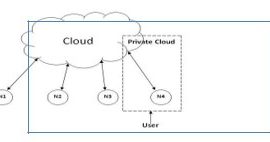
Fig -5: Private Cloud Deployment Model
Community Cloud(Grouped Cloud)
A community cloud provides a distinct and secure environment where organizations with similar requirements share a common cloud infrastructure. So it is called as generalization of a private cloud where a private cloud infrastructure is only accessible to permissible users as shown in the figure-6. It may be managed by the organizations or a third party and may exist on premise or off premise. [18,19,21]
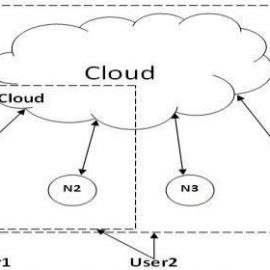
Fig -6: Community Cloud Deployment Model
Hybrid Cloud(Mixed cloud)
A hybrid cloud provides an integrated environment accessible to both private and public cloud functionalities. Therefore, an organization can maximize their efficiencies by employing public cloud services along with private cloud ensuring that all of their proposalss are virtualized. Organizations who manage their private clouds first registered to a public cloud service which they then integrate into their infrastructure. The figure-7 shown below is the deployment model for hybridcloud.[19]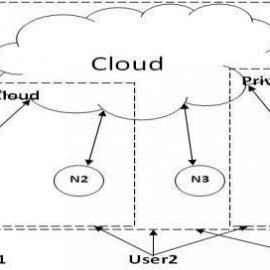
Fig – 7: Hybrid Cloud Deployment Model
,outlines the importance of e-gov cloud and its visibility and readiness over time.[22]
Cloud Based E-Governance System
So for e-gov cloud infrastructures, application and data usages of e-governance modality can be mapped to the three different service models such as Infrastructure as a Service (IaaS), Proposals as a Service (PaaS), and Software as a Service (SaaS) and can also be deployed in the form of Public cloud, Private cloud, Hybrid cloud and Community cloud. It gives a proposals to use the applications(G2G,G2C,G2B,G2E) in the form of services which is more scalable, trustworthy, high performance and relatively low cost as compared to other implementation of e-governance services. The figure-10 represents the e-governance modality services with cloud Infrastructure.[6][22][23] table-1 and table -2 represents the egov confronts and cloud benefits including the resource analysis.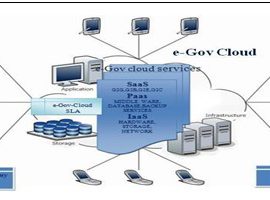
Fig-8:E-Gov cloud using cloud infrastructure
Table-1. E-Gov confronts and cloud benefits
|
S.No |
E-Gov Confronts |
Cloud Benefits |
| 1. |
Reducing Costs |
Deploying the e-gov services in cloud substantially decreases the processing costs of many activities compared with the manual way of handling operations. Efficiency is also attained by streamlining internal processes and by enabling faster and more informed decision making.[22] |
| 2. |
Promoting Economic development |
Cloud implementations regardless of the deployment models tend to be as large as possible in order to take advantage of economies of scale. Large cloud deployments can often be located close to cheap deployment to lower cost. It does not require upfront investment and much capital expenditure. It advances resource utilization and makes the service deliverance more efficient. .[22] |
| 3. |
Enhancing Transparency and Accountability |
Users in cloud environment can access computing resources as and when needed, without any human interaction. Capabilities can be rapidly and elastically provided in some cases automatically. It advances the use of multiple sites which makes cloud computing suitable for business continuity and disaster recovery. .[22] |
| 4. |
Improving Service Deliverance |
New nodes can be added or removed from the network as can physical servers, with limited modifications to infrastructure set up and software. Cloud architecture can scale horizontally or vertically according to the users requirements . Capabilities are available over the network and accessed through standard mechanisms that promotes by using heterogeneous proposalss (like mobile phones, laptops, and PDAs). .[22] |
| 5. |
Facilitating an e- Society |
Once registered in the cloud environment any one can access the information from any location provided, there is an Internet connection. For deployment storing information in the cloud gives almost unlimited storage capacity. Hence no more need to worry about running out of storage space or increasing current storage space availability. .[22] |
| 6. |
Improving Public Administration |
E-government administrative components, such as a computerized treasury, integrated financial management information systems, and human resource management systems, lead to greater efficiency in public administration. Features include the integration of expenditure and receipt data, control of expenditure, human resources management, intelligent audit through data analysis and the publishing of financial data. All the above functionalities can be managed by the faster and more informed decision making capabilities provided by CSP.[22] |
| 7. |
Reducing Costs |
Deploying the e-gov services in cloud substantially decreases the processing costs of many activities compared with the manual way of handling operations. Efficiency is also attained by streamlining internal processes and by enabling faster and more informed decision making.[22] |
Table-2. Resource analysis using cloud infrastructure
| S.No |
Parameters |
E-Gov Deployment |
E-Gov Deployment Using Cloud |
| 1. |
Access |
Via web |
Via web |
| 2. |
virtualization |
N/A |
Essential |
| 3. |
Switching cost |
High |
High ,due to incompatibilities |
| 4. |
Ease of use |
Difficult |
Easy |
| 5. |
Business model |
Web based |
Pricing (based on rent rate) |
| 6. |
Application development |
Via web |
In the cloud |
| 7. |
Control |
Distributed |
Centralised/distributed |
| 8. |
Openness |
High |
low |
| 9. |
Service level agreements |
Optional |
Essential |
| 10 |
Production Server Hardware |
Essential |
Provided by CSP |
| 11 |
Web servers |
Essential |
Provided by CSP |
| 12 |
Application servers |
Essential |
Provided by CSP |
| 13 |
Database servers |
Essential |
Provided by CSP |
| 14 |
Production Server Operating Software |
Essential |
Provided by CSP |
| 15 |
Development Server Hardware |
Essential |
Provided by CSP |
| 16 |
Backup server |
Essential |
Provided by CSP |
| 17 |
Laptops and desktops |
Essential |
Provided by CSP |
| 18 |
Development servers |
Essential |
Provided by CSP |
| 19 |
Development Server Operating Software |
Essential |
Provided by CSP |
| 20 |
Network Hardware |
Essential |
Virtualised infrastructure by CSP |
| 21 |
Routers |
Essential |
Provided by CSP |
| 22 |
Switches |
Essential |
Provided by CSP |
| 23 |
Load-balancing systems |
Essential |
Provided by CSP |
| 24 |
Firewalls |
Essential |
Provided by CSP |
| 25 |
Backup system |
Essential |
Provided by CSP |
| 26 |
Other security expenses |
Essential |
Provided by CSP |
| 27 |
Transmission/Bandwidth Charges |
High |
Vary (based on rent rate) |
| 28 |
Facilities/Equipment |
High |
Vary (based on rent rate) |
| 29 |
Man power required |
More |
Less |
| 30 |
Business staff (requirements development) |
More |
Less |
| 31 |
Technical staff (planning and engineering) |
More |
Less |
| 32 |
External contractors/consultants |
Required |
Optional |
| 33 |
Capital |
High |
Vary (based on rent rate) |
| 34 |
Depreciation of server hardware. |
Essential |
Provided by CSP |
| 35 |
Depreciation of network hardware |
Essential |
Provided by CSP |
| 36 |
Hardware majortenance |
Essential |
Provided by CSP |
| 37 |
Hardware upgrades |
Essential |
Provided by CSP |
| 38 |
Software majortenance |
Essential |
Provided by CSP |
| 39 |
Software upgrades |
Essential |
Provided by CSP |
| 40 |
Bandwidth/transmission charges |
Essential |
Provided by CSP |
| 41 |
Post-launch hosting expenses |
Essential |
Provided by CSP |
Conclusion
This paper explains about the better e-governance services than can be available to the users if the services are available through cloud infrastructure. It gives proposals to use the application in the form of services which is more scalable, trustworthy, high performance and relatively low cost as compared to other distributed computing infrastructures. As E-Governance is the application of ITC to enable and exchange the information between the G2G,G2C,G2B,G2E modality of society. Though the E-Gov cloud deployment is a greatest confront of ICT, but the major confront is the security and protection to both government and the citizens. The major objective of this paper is to provide a clear idea about the E-Gov using cloud computing models and outlines the problems and requirements for accepting the e-Gov paradigm in India.
References
[1]. SpeG, A society for promotion of e- Governance [http://www.egovindia.org/ egovernancepaper.doc]
[2]. OECD e-book Citizens as Partners – Information, Consultation and Public Participation in Policy-Making [http://www. oecd.org/publications/e- book/4201131E.Pdf]
[3]. Ministry of Information Technology (MIT)2001’ Electric Governance –
India. [http://egov.mit.gov.in/]
[4]. Dr Ashish RastogiA Model based Approach to Implement Cloud Computing in E-Governance IJCA, 0975-8887,Volume 9 No.7,November 2010
[5]. E-Governance in India : Challenges and Opportunities, unpublished 2010.
[6]. Cloud Computing for E-Governance A white paper, IIIT Hyderabad, India.
[7]. Wikipedia, http://en.wikipedia.org/wiki /Cloud_Computning
[8]. Dimitrios Zissis , Dimitrios Lekkas, Addressing cloud computing security issues, 0167-739X/ © 2010 Elsevier B.V. All right reserved.doi:10.1016/j.future.2010.12.006.
[9]. Huaglory Tianfield,Cloud Computing Architectures, 978-1-4577-0653-0/11/©2011 IEEE.
[10]. Xu Xiaoping, Yan Junhu, Research on Cloud Computing Security Platform, 978-0-7695-4789-3/12 © 2012 IEEE DOI 10.1109/ICCIS.2012.238.
[11]. Understanding Cloud Computing Vulnerabilities, by the ieee computer and reliability societies 1540-7993/11/ © 2011 IEEE march/april 2011.
[12]. Hassan Takabi , James B.D. Joshi, Gail-Joon Ahn, Security and Privacy Challenges in Cloud Computing Environments, by the ieee computer and reliability societies ,1540-7993/10/ © 2010 IEEE , november/december 2010.
[13]. Rafael Moreno-Vozmediano,Rubén S. Montero, Ignacio M. Llorente, Key Challenges in Cloud Computing -Enabling the Future
Internet of Services, Published by the IEEE Computer Society 1089-7801/13/ © 2013 IEEE, IEEE internet computing.
[14]. Zhifeng Xiao and Yang Xiao, Senior Member, IEEE, Security and Privacy in Cloud Computing, IEEE communications surveys & tutorials, VOL. 15, NO. 2, second quarter 2013, 1553-877X/13/ c_ 2013 IEEE.
[15]. Peter Mell, IT Pro July/August 2012, P u b l i s h e d by t h e I E E E Comp u t e r S o c i e t y, 1520-9202/12/ © 2012 IEEE.
[16]. Jianhua Che, Yamin Duan, Tao Zhang, Jie Fan, Study on the security models and strategies of cloud computing, 1877-7058 © 2011 Published by Elsevier Ltd. doi:10.1016/j.proeng.2011.11.2551.
[17]. Xue Jing, Zhang Jian-jun2. A Brief Survey on the Security Model of Cloud Computing” 978-0-7695-4110-5/10 © 2010 IEEE DOI 10.1109/DCABES.2010.103
[18]. Engr: Farhan Bashir Shaikh, Sajjad Haider, Security Threats in Cloud Computing, 978-1-908320-00-1/11@2011 IEEE
[19]. Francesco M.A and Gianni F. An approach to a cloud Computing network, IEEE, August 2008, pp113-118
[20]. S. B. Dash, H. Saini , T. C. Panda, A. Mishra: Service Level Agreement Assurance in Cloud Computing: A Trust Issue, International
Journal of Computer Science and Information Technologies, Vol. 5 (3) , 2014, 2899-2906 ISSN:0975-9646 (2014).
[21]. S B. Dash, H. Saini, T C. Panda, A. Mishra: Prediction of Trustworthiness in the Cloud Computing Environment using Predator-Prey
Model. International Journal of Cloud Computing and Services Science, Vol.2, No.5, pp. 336~344 ISSN: 2089-3337 (2013).
[22]. S. B. Dash, H. Saini , T. C. Panda, A. Mishra: A Theoretical Aspect of Cloud Computing Service Models and Its Security Issues: A
Paradigm, Journal of Engineering Research and Applications ,ISSN : 2248-9622, Vol. 4, Issue 6, pp.248-254 (2014).
[23]. Smitha.K.K, Dr.Tony Thomas, Chitaranjan K.Cloud based E-governance System: A Survey,ICMOC-2012,procedia Engineering(38)|2012,3816-3823.
